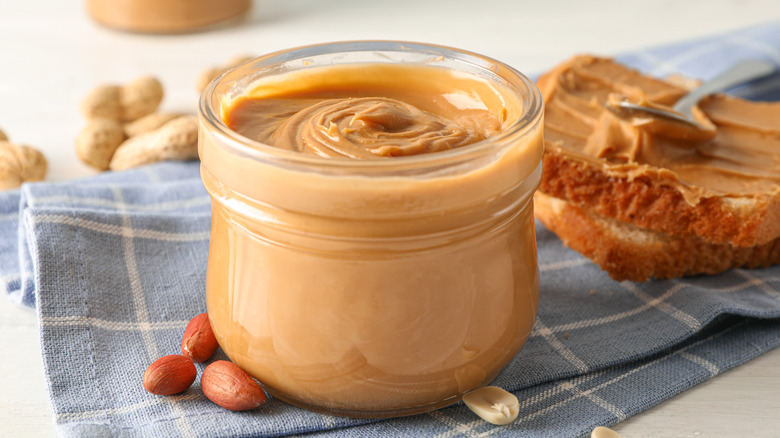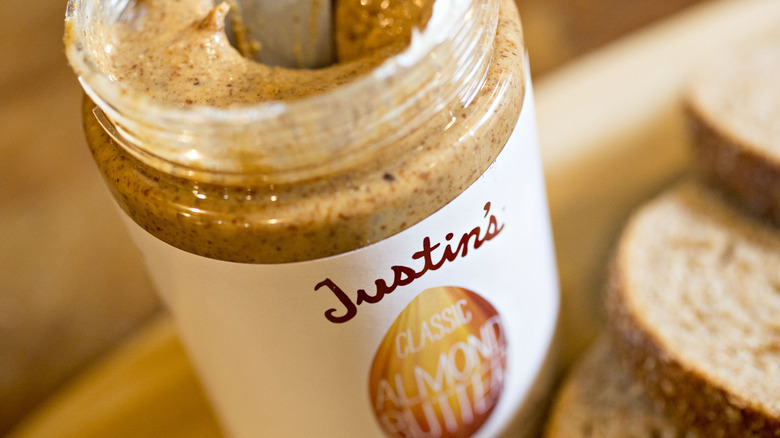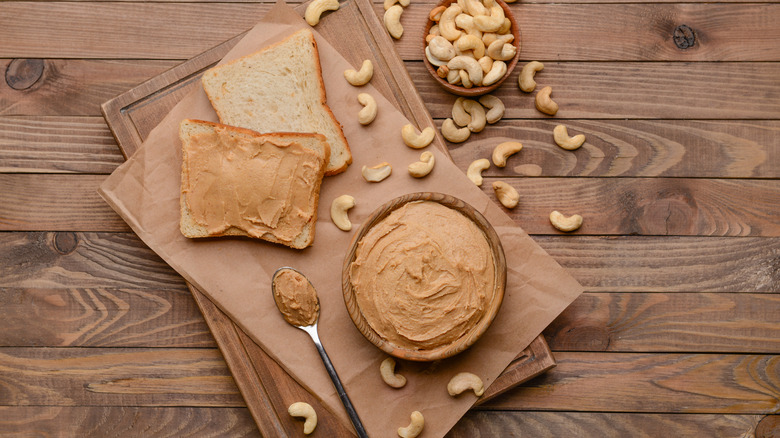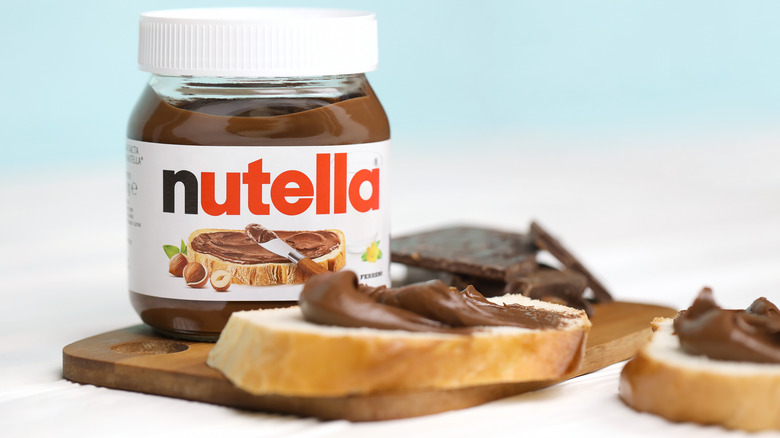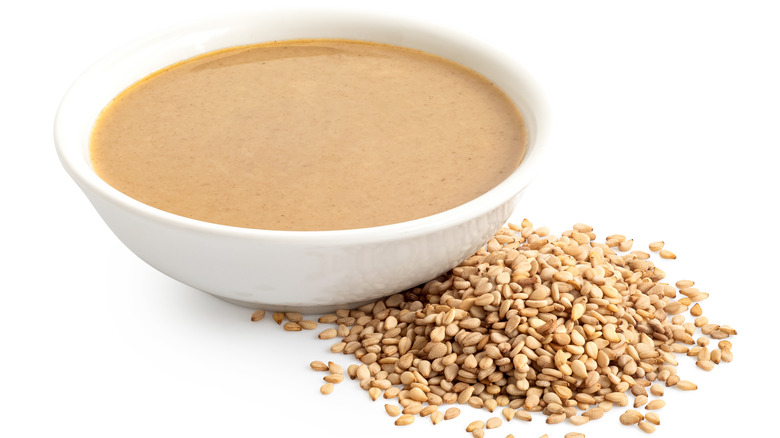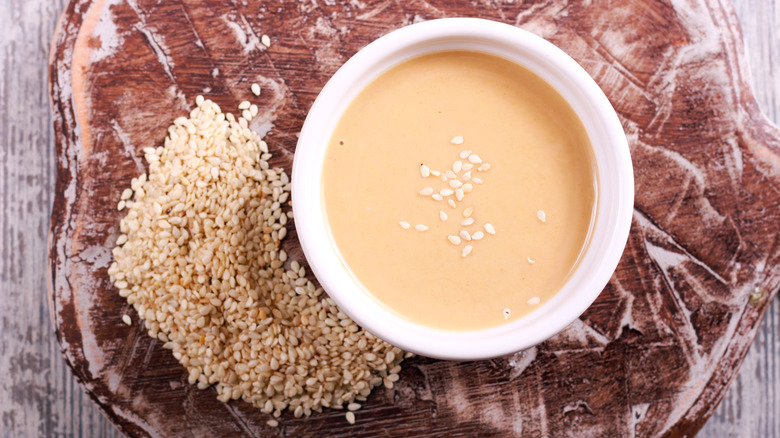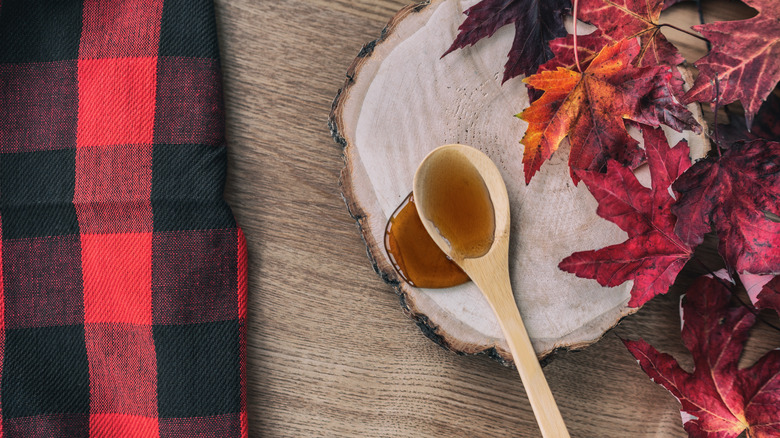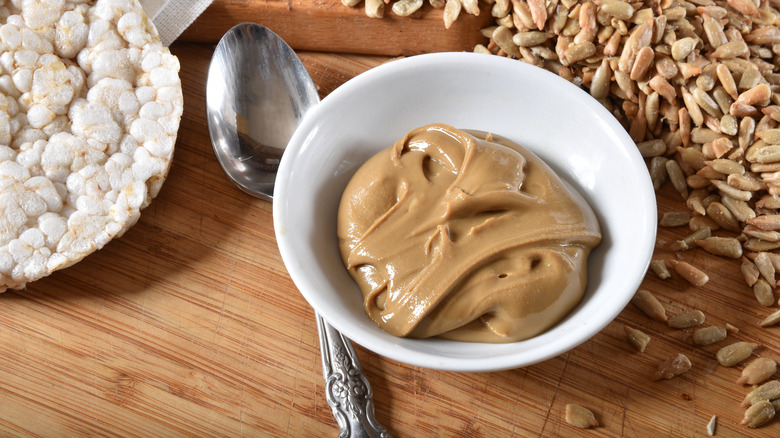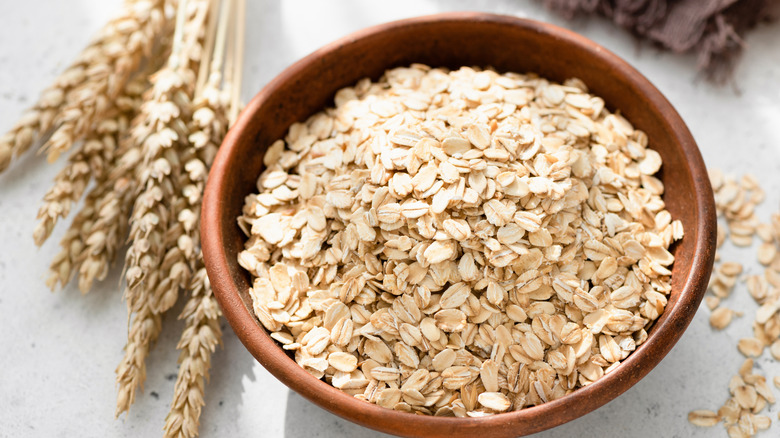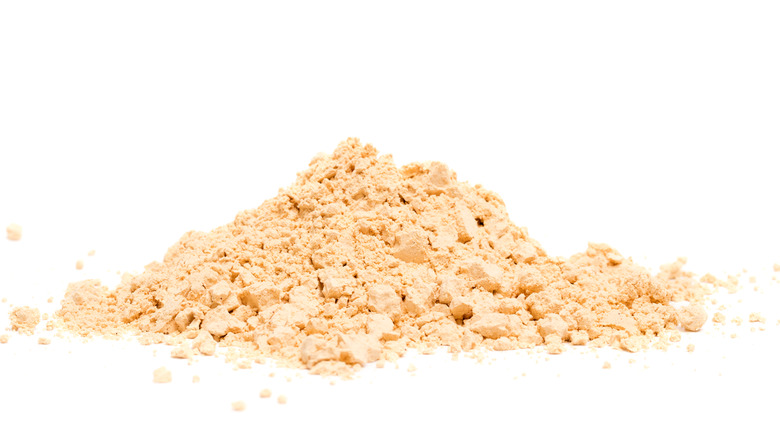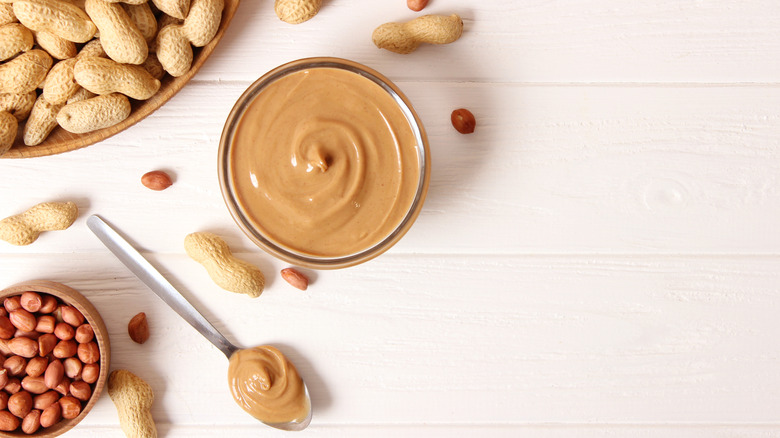10 Best Substitutes For Peanut Butter
Peanut butter is such a beloved food and a prime ingredient in so many sentimental meals and snacks, from the classic PB&J, to Reese's Peanut Butter Cups, and plain old toast. It's great in savory dishes, like Thai noodles and is always a perfect complement to chocolate. Furthermore, peanut butter is full of healthy nutrients, including natural proteins and fats, according to Healthline, and it's readily available in most supermarkets in the United States.
Even so, it was reported in 2020 that there are roughly 3 million Americans with a peanut allergy, according to the National Library of Medicine. So there are at least 3 million Americans out there that haven't experienced the delight of Ben and Jerry's Netflix & Chilll'd peanut butter ice cream, which is a true tragedy. Despite this, there are a good number of solid substitutions for peanut butter if there's an allergy holding you back, or maybe you just don't really fancy it — which is actually pretty common outside of America, according to Insider.
1. Almond Butter
Almonds are taking over the food world by storm, whether that be in the form of almond milk, dips, or nut butters. Almond butter resembles peanut butter in that it contains similar amounts of protein, healthy fats, and natural sugars and is around the same amount of calories per serving, according to Healthline. Like peanut butter, it also comes in crunchy and smooth varieties, and its taste is only slightly smoother and richer.
While it works traditionally as a swap for peanut butter in most cases, Cook's Illustrated doesn't recommend interchanging almond butter for peanut butter in a cookie recipe, as they note it can make the final product flatter than usual. Also, if you have a tree nut allergy, almond butter might not be a suitable swap.
Otherwise, because of their similar consistencies, almond butter can be interchanged with peanut butter in equal quantities most of the time. If you just want to explore what other nut butters are out there besides PB, almond butter is a great one to start with.
2. Cashew Butter
Cashew butter is another popular swap for peanut butter. When cashews are pulsed or blended to make this spread, they still retain their creamy consistency because of their high fat content. This makes cashew butter a great swap in desserts like peanut butter brownies and cheesecakes. Likewise, it's becoming more common to find cashew butter in local supermarkets and large retailers because of its rising popularity.
Unlike peanut butter though, cashew butter has a lower protein content and also shouldn't be used if there is a potential nut allergy. It's also important to note the differences in taste of the two nut butters when making the swap, as cashew butter is more "buttery" in terms of consistency and flavor.
Most of the time though, cashew butter can be subbed for peanut butter in a 1:1 ratio, according to Aberdeen News. Try using it to make cashew butter dessert bars or homemade cashew butter cups.
3. Hazelnut Spread
There was a time when Nutella seemed to be everywhere – in crepes, on sandwiches, and even as a coffee flavor. For many of us, that obsession still continues, and thankfully, there are a lot more hazelnut butters and spreads out there to buy from commercial supermarkets. While Nutella's high sugar content might not make it something to consume every day, pure forms of hazelnut butter can be beneficial for some people, as it can be low in carbohydrates and high in fats, according to Insider.
But as you might imagine, Nutella or any other hazelnut butter probably wouldn't do well in more savory recipes, like a spring roll. But as an ingredient in breakfast items and sweets, hazelnut butter can be quite a good 1:1 substitution for normal peanut butter. So maybe instead of having your usual PB toast in the morning, try it with a hazelnut spread or hazelnut butter instead.
4. Tahini
A Middle Eastern condiment that is traditionally used in hummus, tahini has a similar consistency to peanut butter and is higher in calcium, according to That Clean Life. Only now are people noticing how it can be implemented as a substitute in a handful of recipes but it's been around for generations! Tahini is essentially a mix of olive oil and sesame seeds that have been ground down, making a paste that's similar in texture to peanut butter.
Because it's made from seeds, it's also suitable as a swap for anyone with a tree nut allergy. However, it is important to note that when using tahini as a substitute for peanut butter, there will be an absence of the often strong, dominant flavor of the latter as well as PB's touch of sweetness, which may be quintessential in certain recipes.
As it's known for uses in more savory dishes like hummus, tahini is a great substitute for peanut butter in the more umami flavor recipes. Tahini can be interchanged with peanut butter in equal quantities, as in Calm Eats' sesame peanut noodles recipe.
5. Sesame Butter
Not to be confused with tahini, sesame butter is made by slowly roasting sesame seeds before crushing them to produce a pasty-like substance, according to Toby Amidor Nutrition. Tahini and sesame butter also differ in that the latter has a much more distinct flavor, due to the sesame seeds being roasted prior to being made into a "buttery" form — and that makes for a stronger sesame taste. Nonetheless, both make for equally great substitutes for peanut butter.
Sesame butter has possible health benefits as well, including the combination of protein, fiber, and fats that is often found in nut butters, as well as antioxidant properties. However, if don't already have it on hand, finding sesame butter can be challenging and you may need to purchase it online if you don't live near a supermarket that carries it, according to Pups with Chopsticks.
But once you do get your hands on sesame butter, you'll find it works well in sweet and savory recipes alike. Toby Amidor's blog recommends adding it as a topping to a sweet potato, which is done with peanut butter more commonly than you might think.
6. Maple Butter
Just the name of this concoction alone sounds delicious. Maple butter is a dairy-free fondant that is the result of maple syrup being heated and then cooled into a "butter" that has a thick consistency, according to Maple From Canada. A jar of this good stuff from Trader Joe's is described as spreadable and creamy, and is great on pancakes and waffles, according to Yahoo! Life.
Despite its sweetness, maple butter can also be used in salad dressings and vinaigrettes. However, if you are craving a similar, nutty flavor to peanut butter, you might want to turn to another alternative as maple butter is only usually made out of maple syrup and the occasional addition of a few other ingredients like butter, salt, and cinnamon, so it has an overarching sweet taste.
However, for dessert items and those with a more neutral base (like toast), maple butter can be smeared on in a 1:1 swap and enjoyed in the same way.
7. Sunflower Butter
Another reliable replacement for peanut butter can surprisingly be made out of sunflower seeds. According to the United States Department of Agriculture, sunflower butter has higher iron, manganese, and vitamin E content than peanut butter, and it's made by toasting sunflower seeds before blending them into a "butter" that mimics the taste and texture of traditional PB, says Simply Recipes. You can make sunflower butter at home, too, which may be your preferred choice if you don't like the unwanted sugar that comes in many of the store-bought brands. In this case it's important to read labels carefully.
SunButter is a popular brand of sunflower butter that can be found in many supermarkets. On the company's website, there are a handful of recipes for inspiration, including dishes that are more commonly associated with peanut butter, like these mouthwatering chocolate chip cookie dough truffles. In most cases you can do a 1:1 swap of the two ingredients.
8. Kween Granola Butter
The classic PB&J is still possible even if you or your kids can't eat peanut butter, thanks to a creation known as Kween Granola Butter. Hailed as the world's first spreadable granola, this nut-free spread is made out of oats and comes in a variety of different flavors, including vanilla, cookie dough, and blueberry. It's also gluten-free and packed with fiber, protein, and healthy fats, according to the company's website.
Creator Ali Bonar made her first batch of granola butter only a few years ago, and since then, it's become available in most Whole Foods stores and smaller markets across the country — and it's a hit in nut-free schools. Granola butter has a lot of attractive qualities, and can be eaten alone or as a swap for nut butters, which Bonar told Del Mar Times was her goal when creating the product. Furthermore, despite granola butter having a naturally sweet flavor from the oats and maple syrup used in the blend, it's low in sugar and has minimal ingredients.
In more savory recipes, granola butter might not be the most ideal swap — but go ham on those peanut butter and jelly sandwiches in a substitution of equal quantities.
9. Peanut Butter Powder
Peanut butter is a calorically-dense food, which makes sense because it keeps you full for long periods of time. But it might not be the best for people who are looking to maintain or lose weight. That dynamic has resulted in many turning to peanut butter powder, which cuts out a lot of the calories of normal peanut butter while also allowing PB diehards to get the delicious taste and beneficial protein of the popular nut spread.
The way it's made is by roasting peanuts before putting them through a press to squeeze out oils and fats (the culprits of the higher calories). The paste is then ground into a shelf-stable powder. The resulting product, like popular brand Pb2 Foods, has 8 grams of protein and 2 grams of fat per every 16 gram serving, according to Spoon University.
According to Shape Magazine, 2 tablespoons of peanut butter powder and 1 tablespoon of water equals 1 tablespoon of regular peanut butter. The powder is great in liquids and "soupy" meals like smoothies and oatmeal, but if you want your shake to be thicker, you can always add less water.
10. Homemade Peanut Butter
If you have some roasted peanuts, honey, and a bit of salt, you can also easily make your own peanut butter at home using a food processor or blender. This recipe from Pinch of Yum only takes 5 minutes and needs just three ingredients, nixing any added sugars or other unwanted ingredients that might be present in mass-manufactured kinds.
By making your own, you have control of what goes into your peanut butter and can even get creative, adding in chocolate chips, raisins, or even pretzels. Sure, it might not have any of the cool packaging of the store-bought variety, but it'll taste even more delicious because you made it on your own.
Use your homemade peanut butter in every way you might use a bottle from the store — the possibilities are endless.
